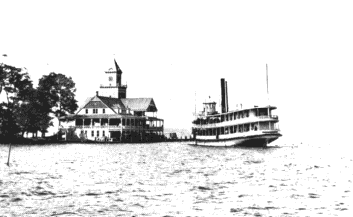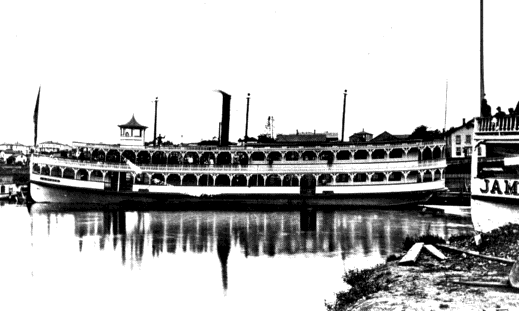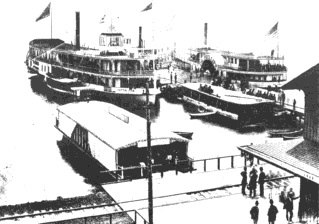
The paddle steamer "Jamestown", built in 1875, navigates the Outlet from Chautauqua Lake as it approaches the Boat Landing in Jamestown, New York
The Steamship
by Juan Wilson

The paddle steamer "Jamestown", built in 1875, navigates the Outlet from Chautauqua Lake as it approaches the Boat Landing in Jamestown, New York
The Steamship
by Juan Wilson
The Fenton Historical Society in Jamestown has produced three excellent publications that document some of the past glory of the Chautauqua region. This article is the first in a three part series featuring these books which cover phenomena almost extinct today: Steamboats, Hotels and Trolleys.
We are going to survey these three books in this issue of the Gobbler. The cultural and commercial dynamics that developed after the Civil War manifested themselves in the completion of several diverse infrastructures that enhanced the comfort of life in our area. Before the First World War these elements came together to create a way of life almost unimaginable today. By the Second World War, these same elements had all but disappeared.

The "Mayville", "Cincinatti", "New York", and "Buffalo" docked at the Boat Landing in the 1920's.The "Cleveland" was uplake when the photo was taken. Note the trolly on its way from Jamestown to Lakewood along Fairmount Avenue.
Certainly, the first of these phenomena were the steamboats. They were perhaps the most unique and glamorous of the past glories of Chautauqua County. As early as 1828 the steamer "Chautauque" began to paddle its way the length of the lake between the county seat in Mayville and the industrious city of Jamestown. At that time there were few settlements between the two ends of the lake.
The "Chautauque" ceased operation in 1836. In that same year the steamer"Robert Falconer" began a service that lasted until 1847. Its operation included a schedule that maintained a connection by stagecoach from Mayville to Barcelona. There passengers could board a ship to Buffalo that sailed in Lake Erie. These and about 30 smaller steamers were used as ferry and excursion boats on the lake. Some boats were built and used elsewhere before they reached Chautauqua. The "Celoron" and the "Greenhurst" were sister ships commissioned as part of a fleet of boats for use on Lake Michigan during the World's Fair in Chicago. In 1895 they were shipped to Jamestown for ferry service in the lower lake. In the upper lake, other small boats like the "Rochester" and the "Mayville" ran service between Mayville and Chautauqua.

The "New York" docks at Chautauqua Institution landing, buit in 1886. Next stop... Point Chautuaqua!
It wasn't until 1863 that large steamers began service on Chautauqua. Only 15 great white steamers were built. All were built on the shores of Chautauqua between the Civil War and the turn of the century. Many of these ships sailed under different names during their history, consequently, there are almost 40 names for the great steamers that plied the lake.

In August 1908 the "Cincinnati" strikes a piling at Chautuaqua Institution. Aiding her is the "Rochester".
Of the fifteen, just three were equipped with stern wheels, while another three were laid out with side wheel paddles. The rest were propeller driven. One of the stern wheelers, the "May Martin" had both stern and side wheels. All these ships used coal to generate steam for power. The coal was supplied at the Boat Landing in Jamestown.
The big boats averaged about 120 feet in length and 20 feet in width. The largest built was the "Jamestown" with a length of 175 feet and a beam of 31 feet. This boat had three decks and it is claimed in the Fenton Historical Society publication that it had the capacity to carry 3000 people.

Built aws the "J. A. Burch" in 1880, this propeller ship was the second largest steamboat ever on the lake. For a few years she was known as the "Hiawatha", but in 1892 was renamed "The City of Chicago". The "Chicago" burned in drydock in 1903, behind what is now Quality Supermarket on Fuvanna Avenue.
This is an incredible statistic to me, for the boat would have provided less than a two foot square for each passenger (with no space left over for superstructure aisles, or stairs). Keep in mind, the 94 foot long "Chautauqua Belle" was commissioned in 1976. It has two decks and has a capacity of 110 with a crew of 4. It is my estimation the "Jamestown" more likely had a capacity of 300 than 3000.
To the north, in Mayville, the steamers were linked to the Pennsylvania Railroad, with connections to Pittsburgh and Buffalo. To the south, in Jamestown (and Lakewood) the steamers were linked to the Erie Railroad with connections to Chicago and New York.
Consequently, during the summers of late l9th century and into the 1920's tourists from the most heavily populated cities in America could reach the cool and sunny waters of Chautauqua Lake for summer rest and recreation. The area flourished.
At their peak, there were nine primary landings for the large Steamers between Mayville and Jamestown. They were Point Chautauqua, Chautauqua Institution, Midway Park, Maple Springs, Sylvan Park, Bemus Point, Stow, Lakewood, and Celoron.

Good Times: The busy dock in Myville in 1875. Steamships waiting for the Pennsylvania Railroad.
Until the 1920's Chautauqua Lake grew as a popular recreational destination. Amusement parks, golf courses, great hotels and other amenities rimmed the shore. As the automobile became mass produced and widely available, transportation needs changed. Some steamers continued service, but the glory days were gone before the Great Depression began. The "Jamestown" continued regular service until the season of 1956. This was much later than steamboat service on other lakes of comparable size. But in 1957 the owners declared bankruptcy. With the exception of a few excursions the "Jamestown" remained idle, boarded up, and tied at the Boat Landing. In September of 1963 she was fired for the last time. She made a trip to the lower end of the lake. That evening a fire was discovered on board. It was put out and the ship was laid up in the first bend of the Outlet. The "Jamestown" was then the object of continued vandalism until the superstructure was removed in 1967. Of the fifteen large steamers, nine burned. The rest were taken from service and eventually demolished.

Bad Times: The wreckage of the side paddle wheeler "Chautauqua" after a boiler explosion in 1971.
Fortunately, there has been a rekindling of interest in Chautauqua steamers. In 1976 James Webster of Falconer built the paddle wheeler "Chautauqua Belle" and more recently completed the steamer "Griffith II".
Russell Fuscus, former leaseholder of the Casino in Bemus Point, displayed early steamship memorabilia in a small museum until last summer when his lease was terminated and the museum were auctioned. Besides many photos and details from the ships, the museum included the rudder and quadrant of the "City of Jamestown". The steam engine of the "Jamestown" sits outside the entrance to the Fenton Museum, in Jamestown, a donation of Mr. Webster.
We congratulate the Fenton Museum for its superb publication "Chautauqua Lake Steamboats" and urge those interested to visit the Fenton's gift shop and purchase a copy. You may reach them at:
The Fenton Museum
Fenton Mansion
67 Washington Street
Jamestown, NY, 14701
(716) 664-6256
Hours: 10 am to 4 pm Monday through Saturday